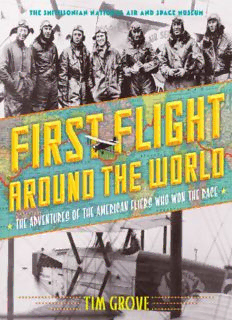
First flight around the world : the adventures of the American fliers who won the race PDF
Preview First flight around the world : the adventures of the American fliers who won the race
FOR MY UNCLE, PAUL J. SEBASTIAN, BORN THE YEAR OF THE WORLD FLIGHT Library of Congress Cataloging-in-Publication Data Grove, Tim, 1967– First flight around the world : the adventures of the American fliers who won the race / by Tim Grove. pages cm. Includes bibliographical references. ISBN 978-1-4197-1482-5 1. Flights around the world—Juvenile literature. 2. United States. Army. Air Corps—Juvenile literature. 3. World records—Juvenile literature. I. National Air and Space Museum. II. Title. TL721.U6G58 2015 910.4’1—dc23 2014024665 Text copyright © 2015 The Smithsonian National Air and Space Museum For illustration credits, see this page. Book design by Sara Corbett Published in 2015 by Abrams Books for Young Readers, an imprint of ABRAMS. All rights reserved. No portion of this book may be reproduced, stored in a retrieval system, or transmitted in any form or by any means, mechanical, electronic, photocopying, recording, or otherwise, without written permission from the publisher. Abrams Books for Young Readers are available at special discounts when purchased in quantity for premiums and promotions as well as fundraising or educational use. Special editions can also be created to specification. For details, contact [email protected] or the address below. 115 West 18th Street New York, NY 10011 www.abramsbooks.com CONTENTS JOURNEY OF THE WORLD FLIGHT MAP INTRODUCTION 1 THE JOURNEY BEGINS 2 PLANNING THE TRIP 3 FIERCE WINDS IN ALASKA 4 DISASTER ON THE MOUNTAIN 5 FIRST ACROSS THE PACIFIC 6 COLORFUL JAPAN 7 MECHANICAL TROUBLE IN INDOCHINA 8 THE HEAT OF INDIA 9 A GRAND WELCOME IN PARIS 10 MEETING ROYALTY IN GREAT BRITAIN 11 PLANE IN DANGER 12 ICEBERGS AND FOG 13 THE WELCOMING CROWDS OF NORTH AMERICA 14 JOURNEY’S END EPILOGUE GLOSSARY ITINERARY ENDNOTES BIBLIOGRAPHY ACKNOWLEDGMENTS ART CREDITS INDEX OF SEARCHABLE TERMS INTRODUCTION hen this story took place, the world was very different from what it is today. In the early 1920s, Europe was recovering from World War I, which had brought devastation and great hardship across the continent. Large parts of Asia and the Middle East that now are independent nations were governed by countries like Great Britain and France. To find out what was going on around the world, people read newspapers or watched newsreels—short film clips that were shown before the full-length movie at a theater. Radio, a recent invention, was increasing in popularity, but televisions, mobile phones, and the Internet did not exist. Women were just beginning to make gains in a male-dominated world and were in the process of earning the right to vote in many countries. Travel was very expensive, and people relied on trains or ocean liners to go long distances. Many people had never seen an airplane, except in pictures. In 1924, the U.S. Army sent eight young men on a grand adventure around the world. It was not a voyage of exploration but rather a bold attempt to be the first to circumnavigate the globe by flight. Airmen from five other countries— Great Britain, France, Portugal, Italy, and Argentina—had the same goal, and so the quest became a race. Who would win? The trip held many challenges: extreme weather, tricky navigation, fragile planes, a scarcity of airfields, and the necessity of dealing with unfamiliar countries and cultures. The world fliers would be risking their lives, facing one obstacle after another, for the sake of their country’s pride. It would be an honor for the United States to be the first to conquer the world by air. For the fliers it was a once-in-a-lifetime opportunity. THE OFFICIAL INSIGNIA THAT WAS PAINTED ON EACH PLANE. THE LIGHT BLUE CLOUD SHAPE FEATURED TWO BALD EAGLES, SYMBOLS OF THE UNITED STATES, CIRCLING A GLOBE. Many men applied to go on the trip, but the Army needed only eight in all: four pilots and four mechanics. First Lieutenant Leslie Arnold was upset when he found out he had been selected as one of two alternate pilots; it appeared that he wouldn’t be going. But then another person got sick and couldn’t go, and so he joined the crew, although as a mechanic instead of a pilot. He would fly around the world in a plane named the Chicago and keep a journal of his experiences. Both the plane and the journal would one day end up in the Smithsonian National Air and Space Museum in Washington, D.C. More than 400 photographs taken on the flight would become part of the museum’s archives. This account of the World Flight is based, in part, on Arnold’s journal. THE NO. 1A AUTOGRAPHIC KODAK JR. CAMERA CARRIED BY LOWELL SMITH ON THE WORLD FLIGHT.
Description: